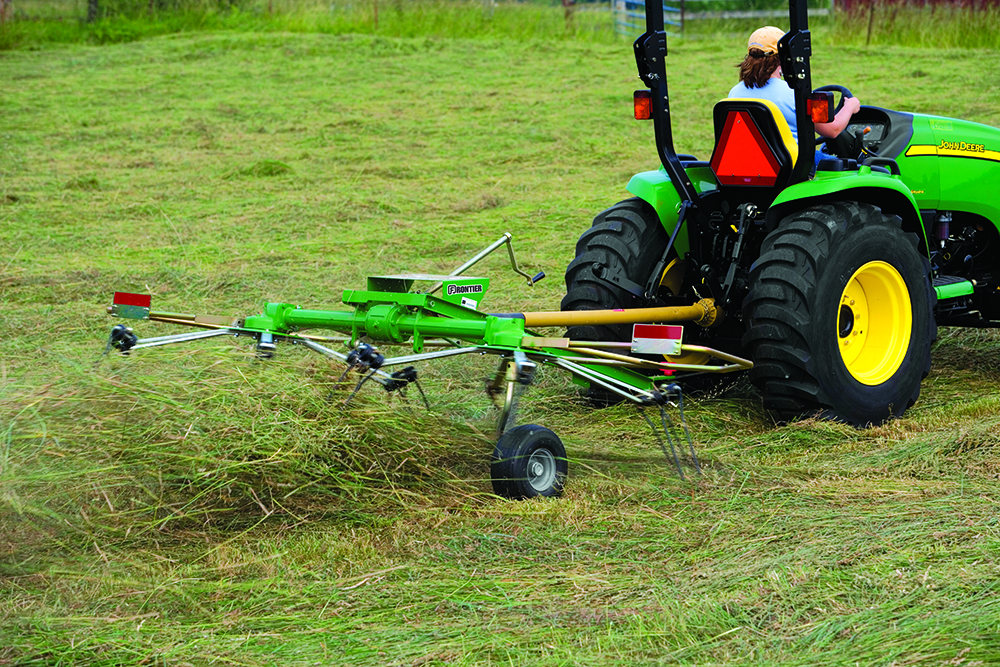Heritage Tractor Blog
The 5 Steps of Haymaking

Producing your own hay begs many questions, even if you’re not a first timer. Do I need to use a tedder? What makes a good windrow? Is it better to make round bales or square bales? What are the advantages of silage?
There are many factors that go into haymaking, but for some farm operations, cutting your own hay is a great choice. Smaller farms with the field space and livestock can reduce the cost of feed and save money in the long run by producing hay.
Hay production involves 5 keys steps: Cutting, Drying, Raking, Baling, and Storing. Each step requires specific equipment for a successful harvest. A tractor is key for all steps in the haymaking process, however you don’t need a large tractor to get the job done. Tractors as small as the 5045E are compatible with hay attachments and can be a great investment for other property projects. A used tractor is a great way to save money upfront.

Cutting
Mower: John Deere Disc Mowers and Mower Conditioners have easy hookups to save you time and energy. Not sure whether an impeller conditioner or roller conditioner MOCO is right for you? Impeller conditioners or flail type are recommended for grasses as they are gentler on the leaves. Roller conditioners come with steel or rubber rollers and are best for legume crops such as alfalfa as they smash the crop to allow drying.

Drying & Raking
Tedder: Hay tedders are used to assist the hay drying process in the field after it is cut. Favorable hay is fresher and greener, meaning it has not sat in the field as long. Not all operations use tedders, instead using rakes during the drying step. Consider the moisture levels of your crop and climate when choosing what drying equipment to use.
Rakes: Offered in a variety of types and sizes, rakes pile the hay into rows (also call windrows) for proper baling. They can also assist in the hay drying process. You can choose from carted, folding, or high capacity rakes with 8, 10, or 12 wheels. Your salesman can recommend the best rake for your needs.

Baling
Baler: Large or small, square or round—the choices are numerous. The size of bale caters to different buyers— i.e. horse owners may prefer small square bales while cattle ranchers often prefer large round bales to feed. It’s important to note that bales can weigh anywhere from 40 to 3,000 pounds depending on the type of baler and hay.
Storing
Trailer/Wagon: Depending on the amount of manpower your operation has and how much energy you want to spend transporting hay will directly affect your need for a trailer and/or wagon. An attached bale wagon is a great timesaver.
Protection: Some types of hay and bales need protection from the elements while others are not majorly affected by being left in the field. The type of netwrap, type of hay, and size of bale can adjust the hay’s lifespan against mold, spoilage, and combustion from heat.
Fact- A bale’s moisture content is best under 20% and the interior of the bale can reach temperatures of 120°F.
Some hay operations choose to produce silage over dry hay baling as silage does not need to be dried and bales are wrapped air-tight with plastic. Silage is fermented feed that can be easily digested by animals.
Once an operation is established, there are many other useful attachments such as bale spears and bale wrappers that can increase productivity on a farm. Commercial operations have even more equipment like sprayers, windrowers, forage harvesters and front and rear mount mower conditioners. Questions? Contact your local sales expert today.
Go Back to List

